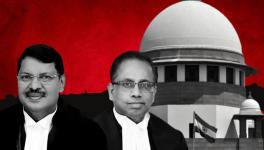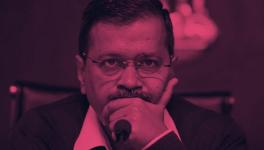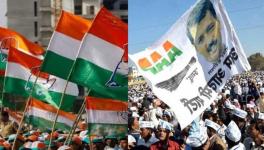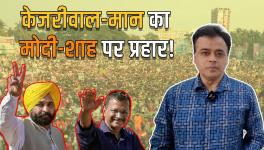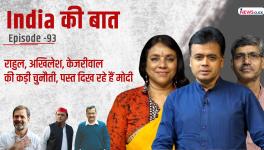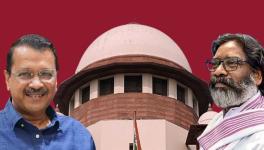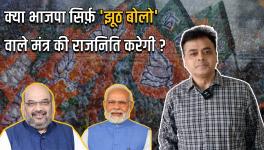Can AAP Bounce Back Again?
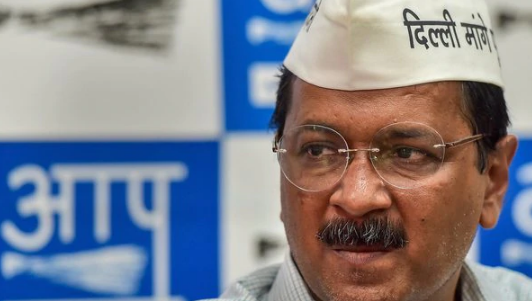
Image Courtesy: PTI
Has the idea of AAP (Aam Aadmi Party) died? No, it's idea and need are not dead. That there should be a political alternative from the grassroots which is of the common citizens without any entitlement whatsoever, and not aligned to any extremes of Right and Left, keeping people's welfare at the centre, and being a force of anti-corruption, cannot be ever over-stated in a large populous and poor nation like India.
Should the AAP change many of its strategies and tactics? Should it re-invent its cherished objectives stated earlier? Yes, it should. This piece is on what and how of these strategies and tactics should it change and re-invent. And it is relevant to relook at AAP with the Delhi state elections ahead, where it currently rules, apart from the Haryana state elections, where it has a presence.
AAP was born against the high command culture which plagues almost all national and regional parties. But it soon fell victim, by default or by design, to another high command of its own. So, first thing first, Delhi Chief Minister Arvind Kejriwal should either resign from the post of party convener or pass the baton of Chief Minister to his deputy Manish Sisodia, and focus as convener in taking the party to the next level. AAP should not be a Kejriwal-centric party and he should not be heading the two most crucial positions. This will be walking the talk for him.
Second, AAP should now have an elected Political Affairs Committee, with members elected from each state in proportion to the number of active volunteers, and in the true letter and spirit of the founding principles of the party. Even the mass front bodies at every level should have elected members. Focusing on mass fronts of students, youths, women, traders, professionals, farmers, workers and their issues is important work never focused by the party yet, except some work in Delhi. The Seva Dal of Congress, Sangh Parivar bodies of the Bharatiya Janata Party, students and workers bodies of the Left parties, have done this same job, which AAP has never worked to evolve.
Third, all district and tehsil committees of the party should be activated with specific district-level development and other issues of the people. Such committees must initiate local-level activities on these issues in collaboration with as many positive forces as possible. The committees can never create local impact depending upon central instruction, without local outreach. And state and district committees need not be controlled and commanded by central 'observers', though they can be mentored. Negative group dynamics have affected several state bodies earlier, especially in Maharashtra and Punjab.
Also, AAP's USP (unique selling proposition) has been its anti-corruption stand and activism. It must start an Anti-Corruption Helpline and Right to Information Centres in each state where it has a reasonable organisational strength to get corruption related information from citizens and work to plug holes or lead movements in the states under state elected bodies of the party, apart from showcasing success stories of their Delhi governance.
Fourth, the nearly 1.5 crore voters of Delhi need to be addressed mohalla by mohalla (neighbourhood to neighbourhood) with a dedicated team of two or three volunteers in every locality, taking all the pro-people measures of the state government to the families, and helping the families under their supervision as much as possible. Engaging with the electorate was done during the Lok Sabha polls, too, but people had a different perspective in electing a central government. It is good to see that Kejriwal himself has got down to connecting with people at the grassroots. But he also needs to engage with his Mohalla Committee volunteers and create leadership on various layers.
For Assembly elections, the focus should be on the AAP government's role. Also, the contrast of the same with the earlier Congress and BJP governments needs to be communicated aggressively. Winning Delhi all over again in spite of central non-cooperation will help AAP establish its political credibility further. AAP has an enviable track record of good work in school education, public health, power, water, completion of road projects, doorstep delivery of government services, et al, and these need to be made visible and communicated to every voter. Each voter must remember what benefits s/he has got during four years of AAP government and what s/he stands to lose if APP goes out of office. The newest decision on free public transport rides for women will have a positive social impact in Delhi and yield electoral benefits for AAP.
Fifth, as a party, AAP must ideally elect a new convener who must reach out to every past member, Left of the centre activists across India, social workers et al for a more broad-based structure. 'Kejriwal's cheerleaders' image of a band of dedicated volunteering social workers needs to be shed. This image has been nurtured by the media and rival political forces, but AAP functioning is also responsible for the same. In its short period of existence, AAP has actually received support from many quarters, and the outreach from the top has to be re-invigorated through the PAC members.
Sixth, strengthening the party in Haryana and Punjab is the next most important task. This can only be done with a democratic approach, accommodating diverse opinions and forces within the party so long as they adhere to the basic values, principles and norms. Short-term gains will not help, as is evident in Punjab. And surrendering to vested interests of small groups or of turncoats at the cost of dedicated volunteers will also have no concrete outcome. Current intra-party imbroglio in these two states bears testimony to this. It is good to note that AAP in Punjab is now completely entrusted to a local team working under the leadership of Bhagwant Mann who is the only Lok Sabha MP from AAP this time.
Seventh, the need to write the party constitution, processes and values afresh, to define the objectives and structure of the party bottoms-up, and to create a standard operating process for mitigating conflicts and ensuring collaboration is needed today more than ever before. There have been several allegations of moving away from earlier declared positions, say, with regard to nomination of candidates etc. These positions must be codified now.
AAP has limited clarity on national security issues, on social justice for dalits and with regard to empowerment of women and minorities. Its most recent known positions have emanated only from the needs of the state government in Delhi, which does a great disservice to the idea of AAP and its evolution pan India. The latest spat between AAP MP leader Alok Agarwal and Delhi Commission of Women CW Chairperson Swati Maliwal on some 'penance activity' of her husband and AAP Haryana leader Naveen Jaihind is a sign of immaturity.
AAP was a whiff of fresh air in the dynastic and religion-dominated Indian politics, and it lost its novelty, maligned by the media and rivals on one side, and falling victim to some populist measures and political posturing, including seen as fighting the PM personally, on the other. Hence, the original principles of volunteer-driven politics and decisions, public fund-raising for operations, mohalla committee-driven development initiatives, complete negation of caste and community-based politics, and preparing constituency-specific manifestos and dialogues-based goals should need to be ensured. These were the novelty features of AAP which have been lost in the din of regular politics. The Delhi elections ahead is a good context for re-inventing AAP on these lines again.
Ninth, AAP has always been known over the last half a decade for articulate spokespersons, young educated volunteers, strong positive social media messaging, creative mass contacts, and contributing to alternate visions of governance and public issues. Once again, AAP needs to resurrect this intellectual capital, and even appoint shadow ministers in every state, as many as possible (out of Delhi state), including the central government, who will follow every central and state ministry, present the AAP perspective in these domains and speak on policy issues that matter in each. For example, the proposed National Education Policy of the government of India needs an AAP response from its perspective of education for all and strengthening public education and its infrastructure, among other things.
Tenth, AAP global has been a strong network of support, funds, people and views. It is in a poor shape now, by all estimates. This global network has been a lifeline and must be re-invigorated. Also, there are experienced volunteers at every level and they need to be taken to the next level with higher responsibilities, while more must join below. India has over two lakh plus elected representatives from the gram sabha level to Parliament. The quest of finding the right person for each of these, bottoms up, is the only way to build a political leadership alternative.
AAP is not about a few known leaders, it is about an alternative vision of politics and governance. Now, in the din of hyped up Right-wing rule in the nation, an alternative vision needs to be strengthened and outreach to the wider masses ensured. Is AAP listening?
The author is a media academic, columnist and participant in TV debates. The views are personal.
Get the latest reports & analysis with people's perspective on Protests, movements & deep analytical videos, discussions of the current affairs in your Telegram app. Subscribe to NewsClick's Telegram channel & get Real-Time updates on stories, as they get published on our website.











